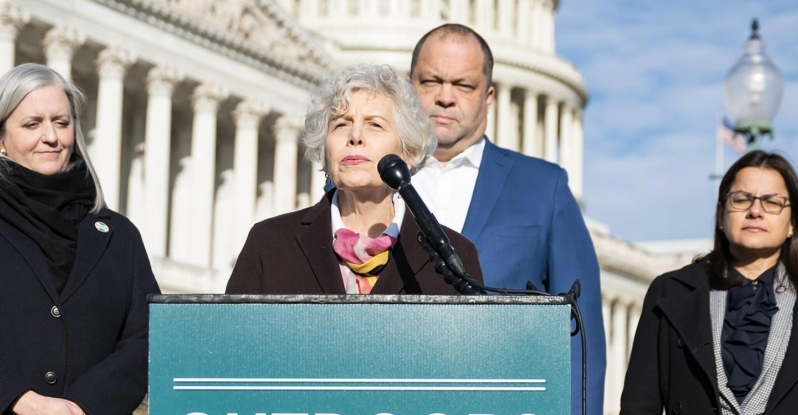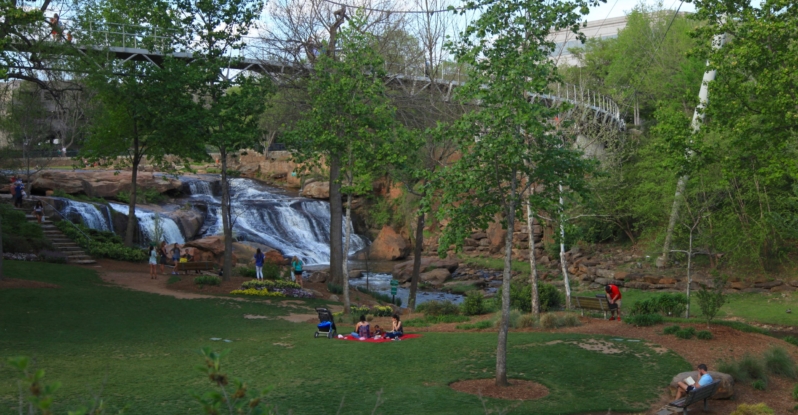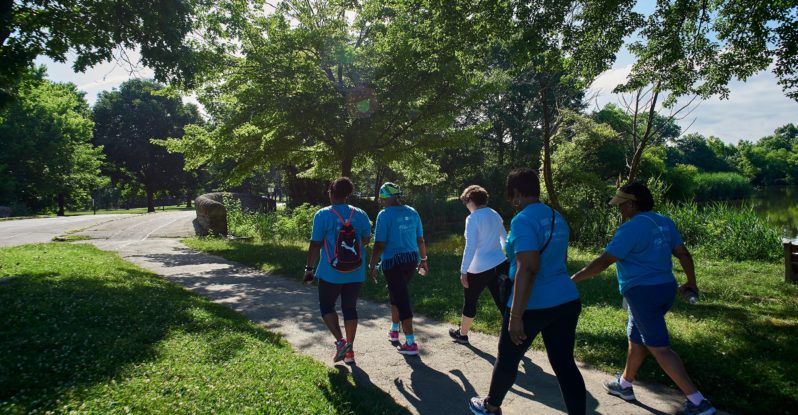Note: Chester Kano, an architect and the Chief of Development Division with the County of Los Angeles Department of Parks and Recreation, was a participant in the Alliance’s St. Louis Park Study Tour. Thank you to Chester for sharing his reflections on his experience with this guest blog.
Is there anything better than a good surprise? Something unexpected that sparks joy?
In our highly curated culture so dependent on knowing as much as possible in advance, I would answer with an emphatic NO.
St. Louis 2023 was my first City Parks Alliance park tour, and I’m loath to divulge that my colleague Sean and I were not expecting much from St. Louis. (Ugh, our coastal bias is showing.) Despite enjoying some delicious BBQ at Pappy’s Smokehouse, we were still scratching our heads during the two-mile walk to our hotel—where are the people? We encountered only a handful during the 45-minute walk down Olive toward the heart of downtown. Ah, this was the decline of downtowns in the Midwest, the shrinking population exacerbated by telework. I walked by an abandoned, windowless building that was probably a bar converted into a daycare business of all things and then left empty to rot.

Blog author Chester Kano shares how City Parks Alliance’s St. Louis Park Study Tour busted his preconceived notions about the city, calling the experience “something unexpected that sparks joy.”
But then little glimpses of St. Louis’s abundant charm revealed themselves. Beautiful midrise buildings waiting patiently to be restored into lofts and restaurants. A small, independent brewery. The gorgeous modernist stadium for the MLS St. Louis City SC. And that was just the start.
Sean told me that City Parks Alliance runs the best tours—he’s been to several—and he wasn’t kidding. I’ve never attended such a tightly run program. A word to the wise: allow time before and after the tour to be a tourist—you won’t have any time to spare during the tour. From breakfast shared with attendees from across the nation, to compact presentations in conference rooms, to bus rides timed perfectly, to narrated walks through and around parks, it was all wonderfully choreographed by Catherine Nagel and her excellent team. Even lunches and dinners were packed with multiple speakers; St. Louis Mayor Tishaura Jones, the city’s first African-American female mayor, was a highlighted speaker at our first dinner. We filled our stomachs as the presenters filled our minds, and both were at capacity by evening’s end.
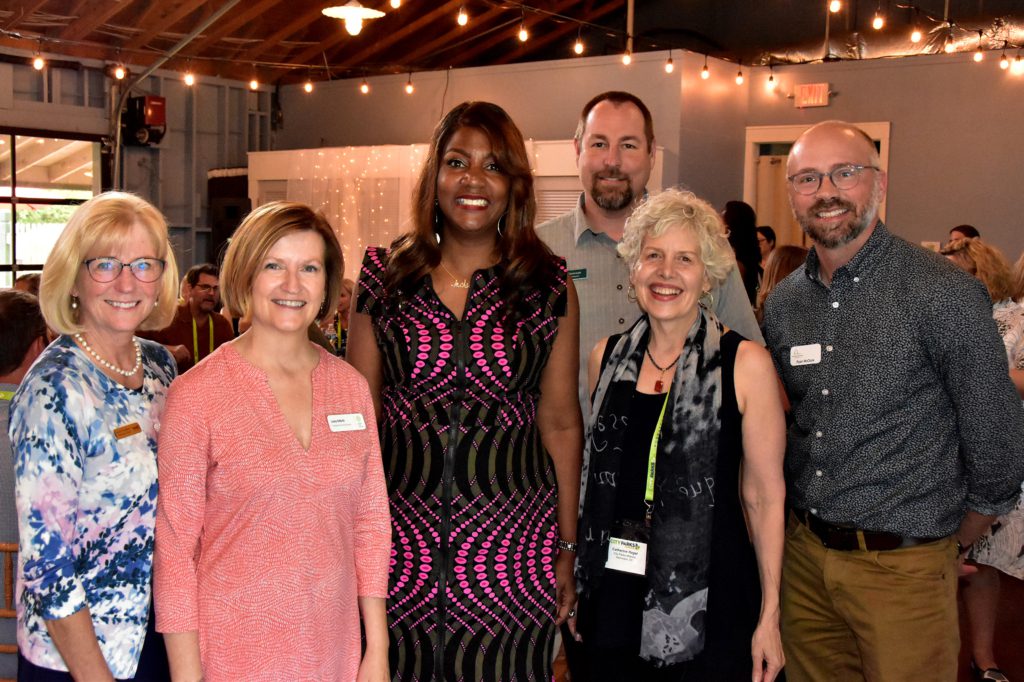
St. Louis Mayor Tishaura Jones (center) with tour organizers and participants.
St. Louis has some amazing, beautiful parks. The 1,300+ acre Forest Park is a national treasure, a great urban park that is more civic center than green space in the mold of New York’s Central Park. Forest Park draws crowds regionally for more than its attractive meadows and mature trees; it brings St. Louisans together for its zoo, art museum, science center, golf and tennis facilities, lakes, Missouri History Museum, and The Muny, the largest outdoor music theater in North America. More than the Cardinal’s ever popular Busch Stadium or even the iconic Gateway Arch, to this outsider I could feel the city’s heartbeat strongest at Forest Park.
Today’s Forest Park, the “Best City Park” in the U.S. (USA Today poll) is the result of a successful public-private partnership between the City of St. Louis Department of Parks, Recreation, and Forestry and Forest Park Forever—what a perfect name for a decidedly forward looking nonprofit. (More on names later!) What struck me about their relationship was its shape, a cross-sectional slice through its most important components. I am more familiar with nonprofits supporting parks with their subject matter expertise, such as programming or historic preservation, or other who focus on raising money. Forest Park Forever employs 50+ staff in every area that matters, from horticulture and capital improvements to fundraising, communications and education.
If you have been involved in park management for very long, you can usually find gaps or dysfunctions between different teams by looking closely at the grounds and facilities. Parks operated in partnership between different agencies or public/private might reveal beautiful landscaping alongside a neglected roadway or a freshly painted restroom under a leaky shingle roof. Behind those incongruencies is likely a chorus of excuses amidst a flurry of finger-pointing. Forest Park’s impeccable maintenance, not to mention the ambition and execution of the nature-centric Playscape project, can only happen through a strong partnership with deeply shared values and committed individuals. I was thoroughly impressed.
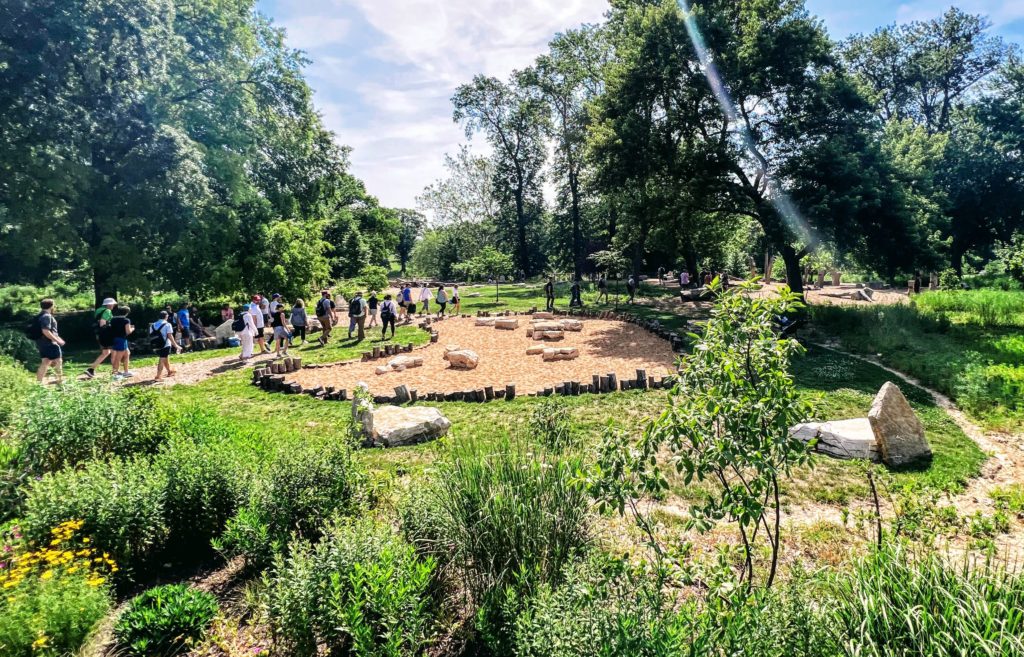
Forest Park’s nature-centric playscape project. (Photo: Chester Kano)
There was an ”ah-ha” moment that came sometime after Susan Trautman, CEO of Great Rivers Greenway, was describing all the great work they do, that they are supported by a 1/10 cent sales tax in the city and two counties, and how they rented their way-too-cool-for-government offices next to a theater and above a live music venue as part of a redevelopment effort. What is this? A nonprofit? No, I was seeing a unicorn: a governmental agency that looks, feels, and operates like a nonprofit in all the best ways including their core values emblazoned across their walls: We do the right thing; we put residents of the region first; we get things done; we value strategy and sustainability; we care; we’re better as a team; we adapt; we stay curious; we have fun.
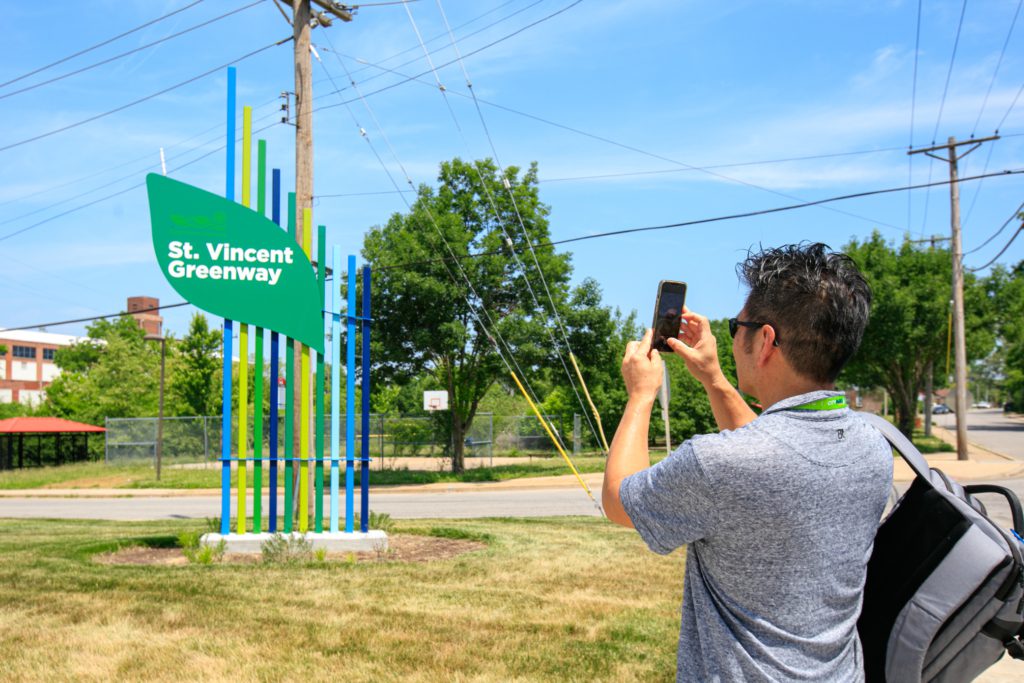
Blog author Chester Kano checks out the St. Vincent Greenway. (Photo: Great Rivers Greenway)
Susan mentioned that the name Great Rivers Greenway is a dba that was necessary because their real name is Metropolitan Park and Recreation District, a Missouri Political Subdivision, and of course we had to change that. Yes! That single move just about says it all. That sensibility infects everything they produce: their core values; the simplicity of their mission – to make the St. Louis region a more vibrant place to live, work and play by developing a regional network of greenways – and, their focused target of 600 miles of greenway of which they’ve completed 130+ miles with another 200 in planning. Something tells me Susan’s superpower is to cut through all the fluff and distraction and get straight to the point. She also hires passionate folks like April Walker, an outreach specialist and “Greenway Ambassador” who, during a bus ride, provided such an ebullient, joyful talk about how much she loves her job that every single person in that bus was smiling ear to ear.
“What’s in a name?” That line, from Romeo & Juliet (which incidentally played at Forest Park’s lauded – and free! – Shakespeare in the Park festival in its inaugural 2001 season and again in 2018), was intended to diminish the significance of names (what’s Montague?). But today, like pronouns, names hold meaning and power to illicit an emotional reaction, to inspire, or in the case of the now-removed Christopher Columbus statue at historic Tower Grove Park, to incite anger. We learned of this episode of the park’s history from Mary Ferguson, Facilitator for Columbus Statue Commission, who led a very thoughtful community-centered process that resulted in a recommendation to maintain the statue (though it was still removed surreptitiously to prevent imminent vandalism). We learned this, by the way, in an impossibly gorgeous atrium building called the Palm House, one of many landmark historic buildings in the park.
The name of Trojan park in nearby Wellston honors the mascot of a now-shuttered local high school. The remarkable partnership of the National Recreation and Park Association, Great Rivers Greenway, local nonprofit Beyond Housing, St. Louis County, and the City of Wellston transformed a 1-acre dirt lot into a vibrant, neighborhood gathering space in an underserved community. Our tour group sheltered under large shade sails next to a splash pad as Wellston Mayor Nathaniel Griffin described the project with much enthusiasm, gratitude, and pride of ownership. The relatively small budget of $2 million makes this award-winning project that much more extraordinary.
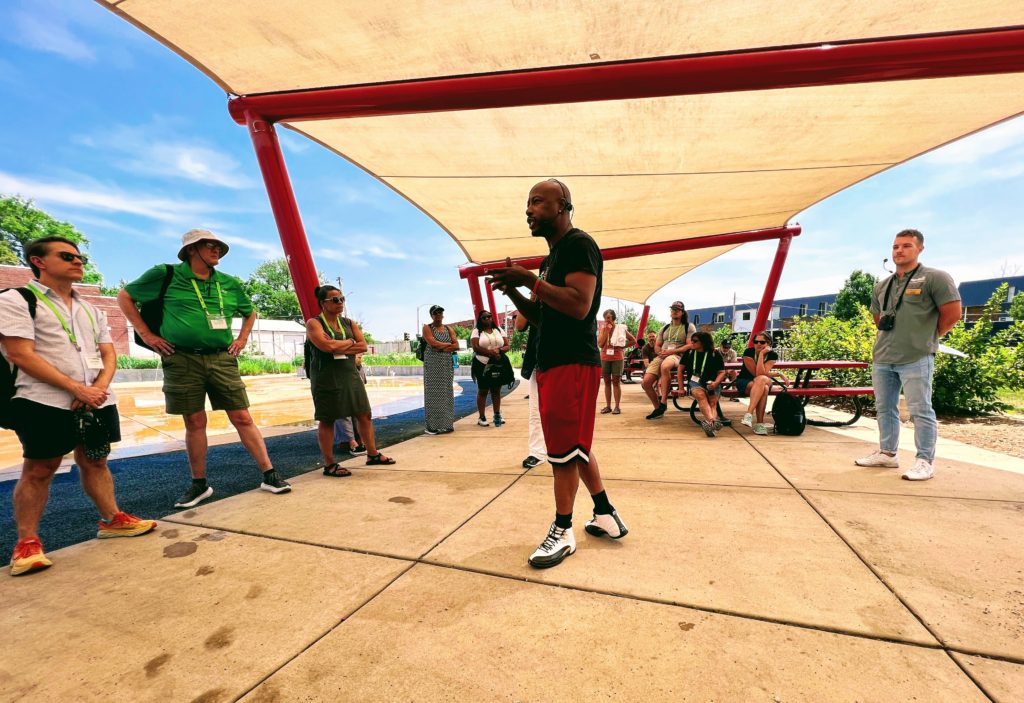
City Wellston City of Wellston Mayor Nathaniel Griffin speaks with tour participants. (Photo: Chester Kano)
Finally, the gleaming stainless steel catenary arch, the definitive iconic symbol of St. Louis, began its life as the Jefferson National Expansion Memorial, an obscure a name as any. In fact, one evening Sean and I visited a local bar where we were corrected by someone who insisted that is still its name. We had learned just that day, though, that the name was changed in 2018 to Gateway Arch National Park. Much better! Wasn’t this the reason we came to St. Louis, to see the arch? By then we had learned and appreciated so much more about the city, but I must admit, as an architect I was smitten. There is no real way to imagine it: 630 feet tall, 630 wide at the base, 54 feet thick at each end, all clad in gleaming stainless steel panels butt-welded end to end. To call it a modernist masterpiece is somehow insufficient.
I ended up visiting the Gateway Arch multiple times, 6am, midday, 6pm, 10pm, to see it in different light. We learned about the fabulous, recently completed museum improvements, the partnership with the Gateway Arch Park Foundation, the wonderful new landscaping along the Mississippi River, and the highway capping that improved connectivity. Most memorable was the work of David Newburger of Universal Design Group, whose thoughtful yet practical approach to accessibility makes total common sense but is nonetheless innovative. There was so much there to learn and be inspired by, but really, it had me at first sight.
Sean was right: these City Parks Alliance park tours are the best. The size was perfect, just large enough to create a strong group energy but small enough to have meaningful conversations with many. I’m so grateful to the entire Alliance team and my fellow tour attendees from across the county (and Toronto!) for sharing stories and now, memories that are in my mind, that transformed St. Louis into a narrative that’s more than just the arch. (Though I still just love that arch!)
Learn more about the St. Louis Park Study Tour, including photos, audio, and more.
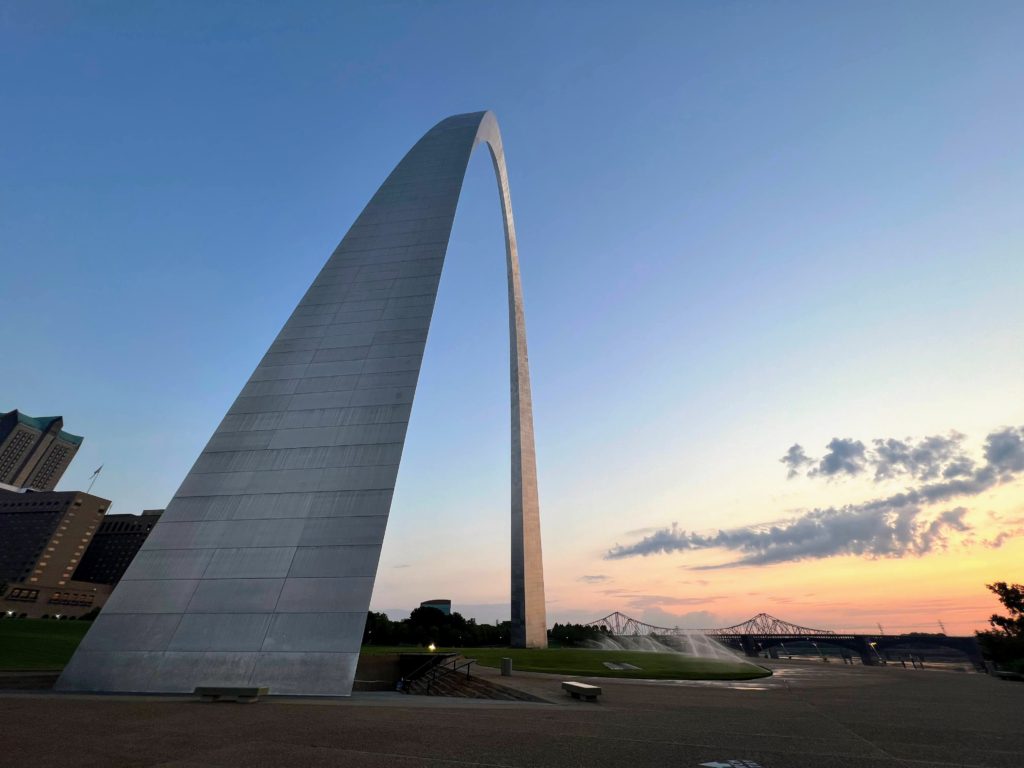
The Arch. (Photo: Chester Kano)

